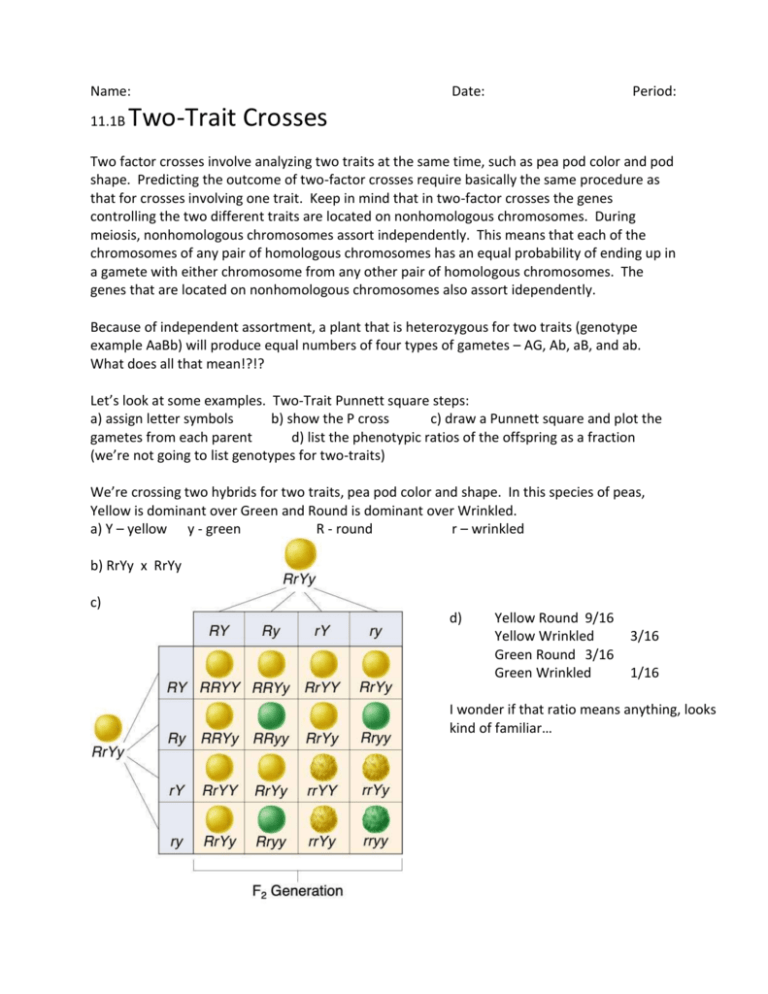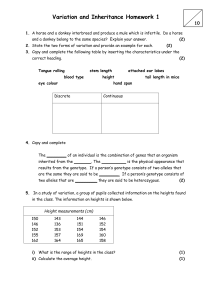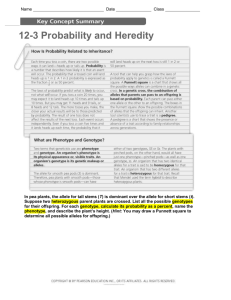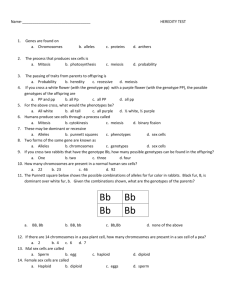Two Trait Crosses
advertisement

Name: 11.1B Date: Period: Two-Trait Crosses Two factor crosses involve analyzing two traits at the same time, such as pea pod color and pod shape. Predicting the outcome of two-factor crosses require basically the same procedure as that for crosses involving one trait. Keep in mind that in two-factor crosses the genes controlling the two different traits are located on nonhomologous chromosomes. During meiosis, nonhomologous chromosomes assort independently. This means that each of the chromosomes of any pair of homologous chromosomes has an equal probability of ending up in a gamete with either chromosome from any other pair of homologous chromosomes. The genes that are located on nonhomologous chromosomes also assort idependently. Because of independent assortment, a plant that is heterozygous for two traits (genotype example AaBb) will produce equal numbers of four types of gametes – AG, Ab, aB, and ab. What does all that mean!?!? Let’s look at some examples. Two-Trait Punnett square steps: a) assign letter symbols b) show the P cross c) draw a Punnett square and plot the gametes from each parent d) list the phenotypic ratios of the offspring as a fraction (we’re not going to list genotypes for two-traits) We’re crossing two hybrids for two traits, pea pod color and shape. In this species of peas, Yellow is dominant over Green and Round is dominant over Wrinkled. a) Y – yellow y - green R - round r – wrinkled b) RrYy x RrYy c) d) Yellow Round 9/16 Yellow Wrinkled Green Round 3/16 Green Wrinkled 3/16 1/16 I wonder if that ratio means anything, looks kind of familiar… 1. If RRYY was crossed with rryy: (R = round, r = wrinkled, Y = yellow, y = green) a. What alleles would be in the gametes from parent RRYY? _________________ b. What alleles would be in the gametes from parent rryy? _________________ c. When the two types of gametes fuse, what is the genotype of the offspring? ________ d. What is the phenotype of the offspring? ______________________________________ 2. RrYy was crossed with RrYy. a. List the 4 possible gametes from parent RrYy: _________________________________ b. What fraction of their offspring will be: Round & yellow _________________ round & green _________________ Wrinkled & yellow _________________ wrinkled & green __________________ 3. In horses, black coats (B) and walking gaits (W) are dominant to white coats (b) and pacing gaits (w). a. If the male horse is homozygous for both dominant traits, what is his genotype? ______ b. What alleles would be found in the horse’s sperm? _________________ c. The female horse is homozygous for both recessive traits, what is her genotype? _____ d. What alleles are found in the horse’s eggs? _________________ e. Construct a Punnett square chart to show the possible offspring from the mating of these two horse types. 4. Now examine the results of mating two horses from the F1 generation. a. What is the genotype of the male horse? _________________ b. What alleles would be contained in his gametes? ______________________________ c. What is the genotype of the female horse? _________________ d. What alleles would be contained in her gametes? ______________________________ e. Construct a Punnett square chart to show the possible offspring from the mating of these two horse types. f. List the genotypic fractions of the possible offspring in the F2 generation. ___ BBWW ___BbWW ___bbWW ___BBWw ___BbWw ___bbWw ___BBww ___Bbww ___bbww g. List the phenotypic fractions of the possible offspring in the F2 generation. ___ black walkers ___ black pacers ___ white walkers ___ white pacers h. Conclusion: Which horse type(s) would be most likely to occur during the F2 generation? ____________________________________________________________ i. Why would this be helpful to horse breeders?






